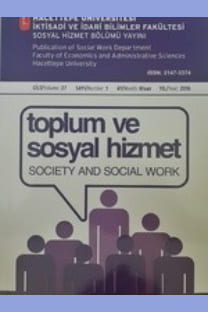ERGENLİKTE KENDİNİ İFADE ETME BİÇİMİ OLARAK DUVAR YAZILARI: SOSYAL HİZMET PERSPEKTİFİNDEN NİTEL BİR ÇALIŞMA
Ergenlik, Gençlik, Duvar Yazısı, Vandalizm, Sosyal Hizmet
Graffiti as an Expression of Oneself in Adolescence: A Qualitative Study from the Perspective of Social Work
Adolescence, Juvenility, Graffiti, Vandalism, Social Work,
___
- Adams, L. K. ve Winter, A. (1997). Gang graffiti as a discourse genre. Journal of Sociolinguistics, 1 (3): 337-360.
- Avramidis, K. ve Drakopoulou, K. (2012). Graffiti crews’ potential pedagogical role. Journal for Critical Education Policy Studies, 10 (1): 327-340.
- Burcu, E., Danacıoğlu, N. ve Vazsonyi, A. T. (2007). Arkadaş grubuna sahip olmaya verilen önemin gençlerin vandalizmi üzerindeki etkisi. Edebiyat Fakültesi Dergisi, 24 (2): 23-44.
- Carrington, V. (2009). I write, therefore I am: texts in the city. Visual Communication, 8 (4): 409-425.
- Cassar, J. (2007). Unveiling desires: adolescents’ hidden graffiti about sexualities and romantic relationships in schooled settings. The International Journal of The Humanities, 5 (4): 179-183.
- Danış, M. Z. (2006). Davranış bilimlerinde ekolojik sistem yaklaşımı. Aile ve Toplum Eğitim Kültür ve Araştırma Dergisi, 3 (9): 45-56.
- Doğan, S. ve Demir, İ. (2012). Genel lise öğrencilerinin okul tahripçilği algıları. Ahi Evran Üniversitesi Kırşehir Fakültesi Dergi-si (KEFAD), 14 (1): 133-147.
- Dener, A. ve Özmen, İ. (2009). Şehir yüzeylerindeki “kötü” sözler. Çevrimiçi Tematik Türkoloji Dergisi, 2 (1): 68-90.
- Green, J. A. (2003). The writing on the stall: gender and graffiti. Journal of Language and Social Psychology, 22: 282-296.
- Gonos, G., Mulkern, V. ve Poushinsky, N. (1976). Anonymous expression: a structural view of graffiti.The Journal of American Folklore, 89 (351): 40-48.
- Halsey, M. ve Young, A. (2006). ‘Our de-sires are ungovernable’ writing grafiti in ur-ban space.Theoretical Criminology, 10 (3): 275-306.
- Kalerante, E. ve Mormori, P. (2005/2006). Graffiti as a form of social and cultural conflict.International Journal of The Humanitie, 3 (4): 129-132.
- Kan, K. H. (2001). Adolescents and graffiti. Art Education, 54 (1): 18-23.
- Kayaalp, L. (2008). “Ergenlikte kimlik ifade-si olarak şiddet” İ.Ü. Cerrahpaşa Tıp Fakül-tesi Sürekli Tıp Eğitimi Etkinlikleri Adolesan Sağlığı II Mart 2008, Sempozyum dizisi No: 63: 33-39, İstanbul.
- Lachmann, R. (1988). Graffiti as career and ideology. American Journal of Sociology, 94 (2): 229-250.
- Lucca, N. ve Pacheco, A. M. (2001). Children's graffiti: visual communication from a developmental perspective. The Journal of Genetic Psychology, 147 (4): 465-479.
- Lynn, N., ve Lea, J. S. (2005). “Racist” graffiti: text, context and social comment. Visual Communication, 4 (1): 39-63.
- McAuliffe, C. ve Iveson, K. (2011). Art and crime (and other things besides...): conceptualising graffiti in the city. Geography Compass, 5 (3): 128-143.
- Moreau, T. ve Alderman, D. H. (2011). Graffiti hurts and the eradication of alternative landscape expression. The Geographical Review, 101 (1): 106-124.
- Othen-Price, L. (2006). Making their mark: a psychodynamic view of adolescent graffiti writing.Psychodynamic Practice, 12 (1): 5-17.
- Öğülmüş, S. (2000). Tahripçilik (vandalizm): düşük yoğunluklu bir sapma. Polis Bilimleri Dergisi, 2 (7-8): 73-86.
- Özbek, M. (1998). Arabesk kültür: bir modernleşme ve popüler kimlik örneği. İçinde S. Bozdağan, ve R. Kasaba (Der.) Türkiye’de modernleşme ve ulusal kimlik: 168-187. İstanbul: Tarih Vakfı Yayınları.
- Pennebaker, J. W. ve Sanders, D. Y. (1976). American graffiti: effects of authority and reactance arousal. Pers Soc Psychol Bull, 2: 264.
- Rodriguez, A. ve Clair, R. P. (1999). Graffiti as communication: exploring the discursive tensions of anonymous texts. Southern Communication Journal, 65 (1): 1-15.
- Stocker, T. L., Dutcher, L. W., Hargrove, S. M. ve Cook, E. A. (1972). Social analysis of graffiti. The Journal of American Folklore, 85 (338): 356-366.
- Stowers, C. L. (2009). American graffiti: the tradition of illegal public name writing in the united states. The Global Journal of Hip-Hop Culture, 4 (1): 62-69.
- Şad, S. N. ve Kutlu, M. (2009). A study of graffiti in teacher education. Eurasian Journal of Educational Reserach, 36: 39-56.
- Taylor, M. F. (2012). Addicted to the risk, recognition and respect that the graffiti lifestye provides: towards and understanding of the reasons for graffiti engagement. Int J Ment Health Addiction, 10: 54-68.
- Varshavsky, T. (2009). The street art plague how graffiti is framed by the press. The Global Journal of Hip-Hop Culture, 4 (1): 70-77.
- ISSN: 2147-3374
- Yayın Aralığı: Yılda 4 Sayı
- Başlangıç: 2000
- Yayıncı: Hacettepe Üniversitesi İktisadi ve İdari Bilimler Fakültesi
YARATICI DRAMA YÖNTEMİNİN KADINLARIN CİNSİYET ROLÜ BİLİNCİNE ETKİLİLİĞİ
Hüseyin ALTINOVA, Ömer ADIGÜZEL
TÜRKİYE’DE SOSYAL HİZMET UZMANLARININ İSTİHDAM DURUMU
SOSYAL ADALET SAVUNUCULUĞU ÖLÇEĞİ GÜVENİRLİK VE GEÇERLİK ÇALIŞMASI
Ayşe Sezen BAYOĞLU SERPEN, Veli DUYAN, Ece UĞURLUOĞLU ALDOĞAN
Türkiye’de kadın hükümlüler: Kadın hükümlülerin profili ve suçluluğa etki eden olguların analizi
SUÇA SÜRÜKLENEN ÇOCUKLAR HAKKINDA HAZIRLANAN SOSYAL İNCELEME RAPORLARININ MAHKEME KARARLARINA ETKİSİ
Semra SARUÇ, Derya KAYMA GÜNEŞ
SAĞLIK İNSAN GÜCÜ PLANLAMASI: SOSYAL HİZMET UZMANLARINA YÖNELİK BİR DURUM ANALİZİ
Selami YILDIRIM, Vedat IŞIKHAN
Doğa BAŞER, Mehmet KIRLIOĞLU, Aliye MAVİLİ AKTAŞ
TÜRKİYE’DE KADIN HÜKÜMLÜLER: KADIN HÜKÜMLÜLERİN PROFİLİ VE SUÇLULUĞA ETKİ EDEN OLGULARIN ANALİZİ
